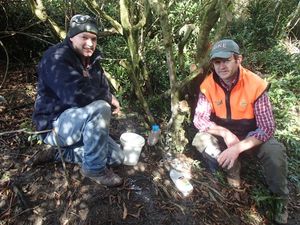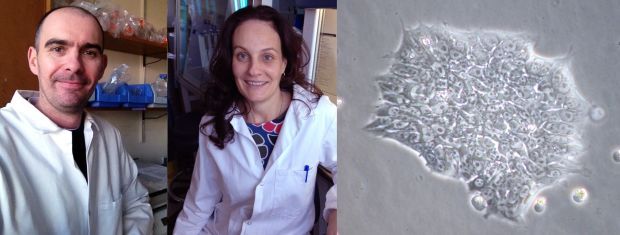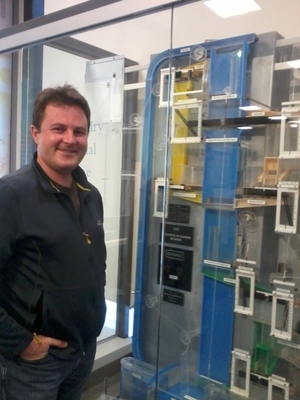Our Changing World for Thursday 15 August 2013
Pest-free Otago Peninsula

Otago Peninsula from Sandymount, with Hooper's Inlet at the right (image: A. Ballance)
 The idea of a predator-free New Zealand has been gaining traction over the last year or so, but one group is already three years into an ambitious six-year programme to remove possums from Otago Peninsula, on the outskirts of Dunedin. The peninsula covers 9500 hectares, and to date more than 6,000 possums have been killed.
The idea of a predator-free New Zealand has been gaining traction over the last year or so, but one group is already three years into an ambitious six-year programme to remove possums from Otago Peninsula, on the outskirts of Dunedin. The peninsula covers 9500 hectares, and to date more than 6,000 possums have been killed.
Alison Ballance joins Brendon Cross, a sixth generation peninsula farmer and chair of the Otago Peninsula Biodiversity Trust, and pest-free peninsula project manager Rik Wilson (both pictured at left) to find out how they are going about the eradication using contractors and ground-based trapping and poison. Because of the peninsula’s geography they have been able to carry out the eradication in different stages, controlling them in one sector before moving onto the next sector. The neighbouring suburbs of Waverley and Shiel Hill will become a buffer zone to prevent possums reinvading.
Kidney Regeneration

From left to right: Alan Davidson, Teresa Holm and a human iPS cells
With diabetes and hypertension on the rise, kidney disease is reaching epidemic levels worldwide. Dialysis and kidney transplantation are the only current therapies, both of which are expensive and have major shortcomings.
New treatments are urgently needed and one possibility is pluripotent stem cells. These cells have the ability to become any cell type in the body and it is now possible to ‘reprogram’ mature adult cells to a pluripotent state. These cells, known as induced pluripotent stem (iPS) cells, are virtually identical to embryonic stem cells, but without any ethical issues.
Kidney tissue can be regenerated in zebrafish using stem cell therapy, and Alan Davidson and Teresa Holm believe that an equivalent therapy for humans can be developed by converting human iPS cells into kidney stem/progenitor cells. It may mean that one day kidneys can be regrown by repopulating a kidney with iPS cells, by using the original kidney as a scaffold.
Alan and Teresa’s work is funded by the Cystinosis Research Foundation (USA), Valrae Collins, The Rutherford Foundation Trust, Auckland Medical Research Foundation and The Maurice & Phyllis Paykel Trust. Ruth Beran meets Alan and Teresa in the laboratory, where she gets to see some beating heart tissue created using iPS cells (as shown below).
Beating heart tissue. from Radio New Zealand on Vimeo.
Bioinformatics and Epigenetics
Much-awarded Australian statistician Terry Speed was in New Zealand recently delivering a series of lectures for the Royal Society of New Zealand on the topic ‘understanding epigenetics through mathematics ‘. Terry Speed works at the Walter and Eliza Hall Institute of Medical Research in Melbourne helping scientists to assess which genes are being turned on in a cell and to what extent.
Get off the Grass
 Agriculture has long been New Zealand’s economic backbone, but Shaun Hendy, a professor of computational physics at the MacDiarmid Institute and an industry and outreach fellow with Callaghan Innovation, argues that our long-term prognosis looks grim as economic growth continues to lag behind other countries in the OECD. In Get off the Grass, a book he began writing with the late Sir Paul Callaghan, the authors explore how innovation works and how New Zealand could grow its economy faster by fostering communities of innovators, entrepreneurs and businesses - and exporting knowledge rather than nature.
Agriculture has long been New Zealand’s economic backbone, but Shaun Hendy, a professor of computational physics at the MacDiarmid Institute and an industry and outreach fellow with Callaghan Innovation, argues that our long-term prognosis looks grim as economic growth continues to lag behind other countries in the OECD. In Get off the Grass, a book he began writing with the late Sir Paul Callaghan, the authors explore how innovation works and how New Zealand could grow its economy faster by fostering communities of innovators, entrepreneurs and businesses - and exporting knowledge rather than nature.
The book looks at the relationship between scientific progress and economic growth, and how innovation can transform a country's economy. Given New Zealand's small size, Shaun Hendy (pictured here with the Moniac analogue economic model designed by New Zealand-born economist Bill Phillips in the late 1940s) says more investment in science and technology is necessary to stimulate innovation and to "innovate like a city of four million people". He argues for more openness and collaboration in New Zealand’s science and innovation system, with a much broader focus than agriculture and the primary sector.
Almost half of the book was drafted when Sir Paul died last year, leaving Shaun Hendy to finish the project. Get off the Grass is published by Auckland University Press, also the publishers of Sir Paul's Wool to Weta. Shaun Hendy won the Callaghan Medal and the Prime Minister’s Science Media Communication Prize in 2012, and he's been blogging about science and the economy at A Measure of Science.